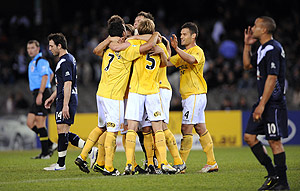
Melbourne Victory's Archie Thompson (right) walks past as the Central Coast Mariners players celebrate winning round 1 of the 2009/10 A-League season in Melbourne, Thursday, Aug. 6, 2009. The Mariners beat Victory 2-0. AAP Image/Joe Castro
In mid-October, I wrote a piece regarding the A-League’s need to better market itself. Here is an example of one area in which the league and teams can drastically improve on.
Social networking sites such as Facebook and Twitter have transformed how we communicate and interact with one another. It also presents businesses, including sporting teams, a platform to engage with their fans and reach out to new ones.
So how have A-League teams and the league itself embraced social media?
Let’s look at how they are represented on Twitter, for example.
Unlike the AFL, NRL and the like – who use their accounts to post links of news articles from their officials sites, post results and fixtures – the A-League has no such account.
It’s a shame.
Surely the A-League could benefit from such a page to help promote upcoming fixtures, promotions and events.
As for the teams, it’s a real mixed bag.
The only Newcastle Jets Twitter page online was last updated on October 24th, 2008, declaring, “Zura almost scored … watch the game here live,” followed by a link to some simulcast of that particular fixture.
Yep, Edmundo Zura. Remember him? He was the guy who didn’t manage a lot of scoring during his spell with the Jets at the start of last season.
Perhaps he was the guardian of Newcastle’s Twitter page, too.
An Adelaide United Twitter page ponders: “Former Sydney FC captain Mark Rudan to join United?”
In case you were one of the 334 followers waiting for an update, yes Rudan did eventually join the Reds.
Gold Coast United – not surprisingly – and Central Coast have no official pages run by the clubs themselves. Perth Glory and the Wellington Phoenix have unofficial pages constantly updating its fans.
But the aforementioned clubs, along with the league itself, are missing the boat.
Having a Twitter account and updating it regularly isn’t going to send the masses scurrying to matches, but it is one of many examples of potential avenues of promotion that isn’t being taken up the custodians of the game.
Moreover, using these mediums is easy and free.
Working with social media networks has been one of the key strategies implemented by the new Adelaide 36ers owners this season.
They have live streaming of matches and press conferences on their website, regular updates on their Twitter and Facebook pages on upcoming matches, player appearances and promotions – offering their Facebook fans a special buy on get one free deal for a recent match – with more on the way.
Despite the ambivalence toward the NBL this season, not to mention a drop in media awareness, the 36ers still pulled over 5,000 people to their game against Cairns Saturday night.
It is, in small part at least, thanks to this type of engagement with its fanbase through the social media, or ‘new media’, platform.
Some A-League clubs are following this example. And some are adopting new marketing strategies to get people to games.
It was encouraging to see Sydney FC offering New Zealanders $10 entry to the match against Wellington on Sunday.
The reward? A very healthy crowd of 10,653 – impressive considering the Phoenix aren’t big crowd-pullers.
It’s these sorts of promotions, helped if they are orchestrated through social media, that make such a difference for leagues that struggle for significant mainstream media attention, and suffer from fluctuating crowds for reasons we’ve discussed at length.
It may seem like a facile example, but the Twitter example typifies a lack of urgency in the marketing and PR departments of the A-League, not to mention a slow uptake on new trends.
Where there is great potential for the A-League with regard to social media is its ability to connect with younger generations who rely on these networks more than traditional media outlets. These platforms enable users to generate, create and absorb their own form of news, bypassing the ‘old media’ if need be.
It is a perfect fit for the A-League, giving it an avenue for distribution of crucial information – such as upcoming fixtures – rather than relying on traditional media outlets.
The league should really target these younger generations. Older generations are encumbered with prejudices regarding sporting tastes and teams.
The teenagers who ‘hang out’ at A-League matches will be the first generation to have grown up solely with the likes of Adelaide United, the Mariners and the rest.
Win over these kids. Engage with them through their preferred forms of communication.
It doesn’t take much effort, but the league and teams will be richly rewarded for jumping on the social media bandwagon and earning and expanding a fanbase.





























































































